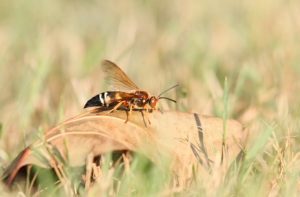 INTRODUCTION: This wasp gets its common name from the fact that it hunts and provisions each of its nest cells with a cicada (Homoptera: Cicadidae) as food for its young. These wasps can become an urban nuisance pest when they select a bare area around a structure as a nesting site. People become alarmed because they look like giant yellowjackets
INTRODUCTION: This wasp gets its common name from the fact that it hunts and provisions each of its nest cells with a cicada (Homoptera: Cicadidae) as food for its young. These wasps can become an urban nuisance pest when they select a bare area around a structure as a nesting site. People become alarmed because they look like giant yellowjackets
RECOGNITION: Large, about 1-1 5/ ” (25-40 mm) long; hairs (setae) unbranched. Color black to rusty with yellowish markings on 1st 3 abdominal segments.
BIOLOGY: Cicada killers are solitary wasps, do not live in colonies or nests, and are females or males as adults. However, many individuals may fly over a lawn and/or they may use the same general area for nesting purposes, but they do not share nests. Each female digs her own burrow which is about 1/ ” (12 mm) in diameter and may extend up to 10″ (25.5 cm) deep. She then locates a cicada, stings it, and brings the paralyzed cicada back to the burrow. One or 2 cicadas may be placed in each burrow and an egg is deposited on one. The wasp larva feeds on the paralyzed cicada. Full-grown larvae overwinter in their burrow, pupate in the spring, and emerge as adults during the summer, usually in July and August. Females will construct and provision many such burrows.
HABITS: Typically, areas of bare ground are used as nesting sites. Many individuals may use the same general area for nesting purposes. While digging their burrow, the females excavate a sizeable pile of soil which can be disfiguring to a lawn.
Females in general will not sting unless handled or stepped on by barefooted children. Males will buzz people but cannot sting.
CONTROL: These are beneficial insects by helping to control cicada populations. If they must be controlled, dusting the bare nesting area with an appropriately labeled pesticide is effective. Pyrethroids and some carbamates are particularly effective. After such treatment has reduced this summer’s adult population, usually within 2-3 days, each burrow should be dusted, aerosol treated, or flooded via a compressed-air sprayer with an appropriate residual to kill the underground developing wasps in order to reduce next year’s wasp population.
The customer should be advised to eliminate all bare-ground areas as a long-term solution to discourage nesting by cicada killers.
